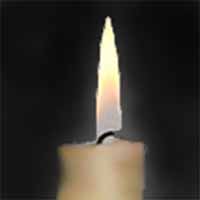
WW2 blackout in the UK

This page describes what the WW2 blackout was, why it was necessary, how it was regulated and innovative ways that families made their blackout and blackout curtains; double summer time is also described. Highlights include recollections from people who lived at the time.
____
Based on the webmaster's childhood observations, contributions from others and additional research
What the Blackout was and why it was necessary
The WW2 blackout in the UK was a mandatory policy to protect against German bombs. It required all lights throughout the country to be turned off or dimmed at night so that the German planes could not clearly identify centres of population or factories.
It is easy to forget how primitive location devices were at the time. There were maps but it was too easy to get off course without landmarks to show where one was. Landmarks of course, could only be seen with light. So, during the blitz of World War Two, no household, no factory and no anything was allowed to show any light at night that might provide a landmark for enemy bombers.
The blackout lasted from September 1 1939, the same day Germany invaded Poland, until the end of the war in April 1945.
The immediate impact of the Blackout on the public
The first real impact of the war on me was the blackout - the dramatic darkness everywhere. From what was previously bright lights and security, all seemed pitch black and menacing.
How the blackout affected lights on vehicles is on another page.
How people made their blackouts and blackout curtains
In 1939 a leaflet on how to set up blackout and why it was essential was distributed to the public. However, as the next boxes show, people developed their own ideas on how best to do it.
Blackout material was not rationed.
Beaver Board was commonly used for blackout. It was a sort of soft fibrous board which could almost be cut with a penknife. It was used with a bar of wood which was thick enough to hold, and which was screwed through the fibre board, so that it could all be lifted up, and put into place. It wasn't too difficult to fit it into the windows, as it was fairly soft and pliable, and quite lightweight.
Dick Hibberd
My mother made our blackout curtains from black material which was off-ration. Several thicknesses were often required. Most housewives made their curtains on treadle sewing machines because electric ones - if they existed at the time - were not luxuries for ordinary people.
Peter Johnson
In our house the blackout was either black wooden boards or wooden frames covered with several thickness of blackout material. I can't remember which. When it got dark these were lifted up and hung from hooks above the window. [This method required the window frames to take hooks, but as they were always made of wood, there would have been no problems. Pat Cryer]
Rosemary Hampton
In our house we used press studs to keep the blackout in place. One half of the press studs were sewn onto the black fabric and the other half were nailed to the window frame.
Mary Elton
How the Blackout was regulated
Being so young, I remember little of the blackout, although I do vaguely recall black linings or black curtains and someone coming to the front door to say that we were showing a light. I later learnt that he was the air raid warden, the ARP man. He was often caricatured as aggressively yelling, "Put that light out!", but I seem to remember him being far more polite.
Double summertime - making the blackout less burdensome
Blacking out lights was made less onerous because the government moved the clocks to make the evenings lighter than they would normally have been. In the same way that the UK has 'summertime' in the summer to give an extra hour of daylight in the evenings, there was 'double summertime' in the war. Clocks were moved two hours forward rather than just the one. I remember finding it difficult to get to sleep in the summer because the sun was still streaming though my bedroom window at 10 o'clock at night. I was not alone in this: it was a topic of conversation for mothers of young children who 'couldn't get the children down at night'. The mornings of course were darker.
Other blackout precautions
Anything white had to be covered at night because it reflected light.
Washing on garden clothes lines
Women had to remember to take in their washing before it got dark because large white items would reflect what little light there was and so indicate to enemy aircraft that they were over a populated area.
Peter Johnson
Extraordinary events in the blackout are on a separate page.
The end of the blackout
On the night of VE Day, no blackout was put up at our windows and we saw the lights of the cottages in the village. We hadn't seen them for the last five years.
Alma Russell
If you can add anything to this page or provide a photo, I would be pleased if you would contact me.
Text and images are copyright
sources: early 20th century material
sources: ww2 home front and other material
contact
the webmaster/author/researcher/editor
privacy policy
















